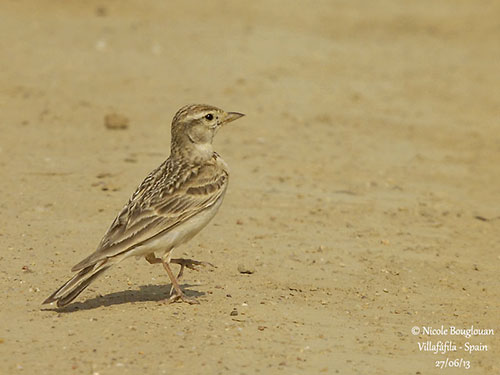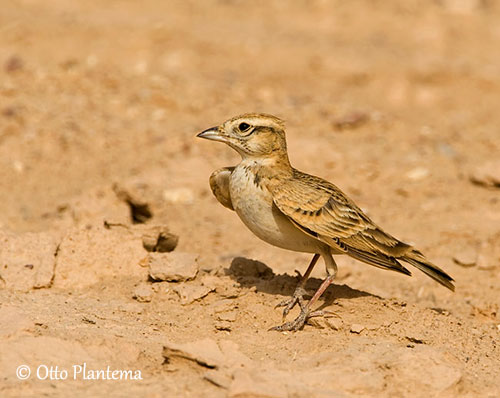
Fr: Alouette calandrelle
Ang: Greater Short-toed Lark or Short-toed Lark
All: Kurzzehen
Esp: Terrera Común
Ita: Calandrella
Nd: dverglerke
Sd: korttålärka
Photographers:
John Anderson
John Anderson Photo Galleries
Didier Buysse
Vision d’Oiseaux
Otto Plantema
Trips around the world
William Price
PBase-tereksandpiper & Flickr William Price
Ingo Waschkies
Bird Photography
Nicole Bouglouan
Photographic ramble & My Spanish Gallery
Text by Nicole Bouglouan
Sources:
HANDBOOK OF THE BIRDS OF THE WORLD Vol 9 - by Josep del Hoyo - Andrew Elliot - David Christie - Lynx Edicions - ISBN: 8487334695
Handbook of Western Palearctic Birds, Volume 1: Passerines: Larks to Warblers by Hadoram Shirihai, Lars Svensson – Editeur: Bloomsbury Publishing, 2018 – ISBN: 1472937589, 9781472937582 – 656 pages
THE HANDBOOK OF BIRD IDENTIFICATION FOR EUROPE AND THE WESTERN PALEARCTIC by Mark Beaman, Steve Madge - C.Helm - ISBN: 0713639601
BIRDS OF THE MIDDLE EAST by R.F. Porter, S. Christensen, P Schiermacker-Ansen C.Helm - ISBN: 0713670169
Breeding ecology of the Greater Short-toed Lark (Calandrella brachydactyla) in southern Turkey
Wikipedia, the free encyclopaedia
Greater Short-toed Lark
Calandrella brachydactyla
Passeriformes Order – Alaudidae Family
INTRODUCTION:
The Greater Short-toed Lark is the most widespread small lark of the Western Palearctic. It appears much smaller than the Eurasian Sky Lark. It is a summer visitor to plains and cultivated areas of the Mediterranean, E to the Middle East, Mongolia and W China. It often winters in the Sahel and S Asia.
In North Africa and the Middle East, the dense migrating flocks fly during the day over the desert in typical undulating flight accompanied by continuous chirruping calls. Eight subspecies share the large range.
The Greater Short-toed Lark usually frequents dry open country and cultivation. It feeds mainly on invertebrates, but seeds and green parts of plants are also part of its diet, depending on the season.
This species nests on the ground in a shallow scrape beside shrub or grass tuft. Both adults care for the chicks.
The Greater Short-toed Lark is affected by agricultural expansion and afforestation of wastelands. However, the population seems to be stable and not globally threatened.

DESCRIPTION OF THE BIRD:
Biometrics:
Length: 14-15 cm
Wingspan: 27-32 cm
Weight: 18-25 g
The Greater Short-toed Lark of nominate race has brown to grey-brown upperparts heavily streaked blackish. On the upperwing, the median coverts have black centres and buff fringes, whereas rest of upperwing is paler. The tail is blackish-brown with brown central rectrices and white outermost feathers.
The underparts are whitish, but we can see a small blackish patch on the lower part of the neck side. The sides of the breast are slightly tinged buff with fine dark streaking, but this is variable. The undertail is blackish.
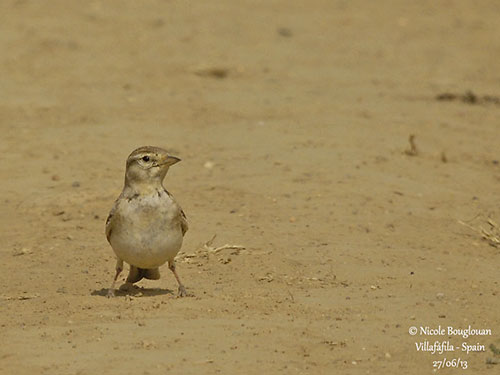
The rufous-tinged top of head is densely streaked. The feathers are erectile. There is a broad, whitish supercilium and the cheeks are grey-brown.
The bill is pale horn with darker tip and culmen. The lower mandible is yellowish. The eyes are dark brown. Legs and feet are brownish-flesh.
Male and female are similar.
The juvenile has whitish scaling and dark mottling on the upperparts. On the underparts, the dusky mottling of the breast often forms an indistinct breast band. The dark neck patches are more or less visible.
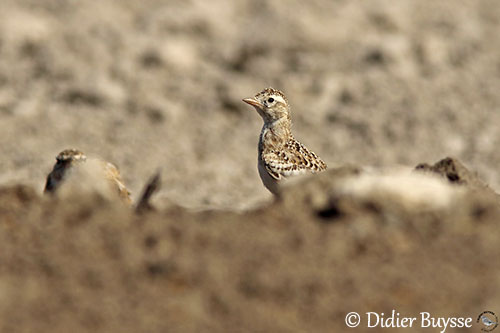
SUBSPECIES AND RANGE:
The Greater Short-toed Lark has eight subspecies.
C.b. brachydactyla (described above) is found in S Europe and Mediterranean islands.
C.b. longipennis is found in Ukraine and S Russia to SC Siberia and S Mongolia. This race is greyish/sandy with fine streaks above and fairly small bill.
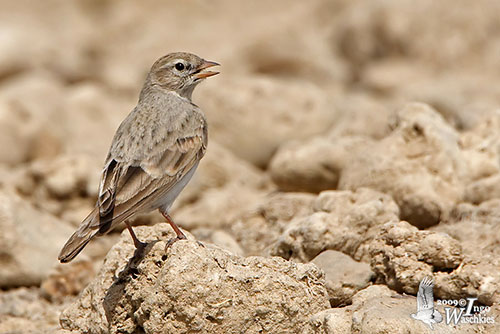
C.b. hungarica of Hungary is buffer and greyer with similar dark streaking.
C.b. rubiginosa occurs in N Africa and Malta. It is more rufous with pinkish/sandy upperparts and finer streaking, and more contrasting rufous crown.
C.b. hermonensis is found in the Middle East, from Sinai to extreme S Turkey. It is also finely streaked, but buffer and less rufous than the N African race.
C.b. woltersi occurs in extreme NW Syria and adjacent S Turkey. It resembles previous but it is paler and greyer.
C.b. artemisiana is found in C Turkey, Transcaucasia and NW Iran. It is slightly darker than “woltersi”, more buffish grey with heavier streaking.
C.b. orientalis occurs in C Siberia, N Mongolia and N China. Not described.
HABITAT:
The Greater Short-toed Lark is common in dry, open country and cultivated areas with sparse, low vegetation cover and sandy or stony soils.
During the breeding season, it is found in fallow lands, dry pastures, tobacco fields and dirt tracks, especially in Mediterranean Basin, whereas in Russia, it frequents more densely covered pastures. It avoids both true steppe and true desert.
It is mainly found in lowlands, although it may occur higher during migration.
During the non-breeding season, it is mainly seen in semi-arid areas and farmland.
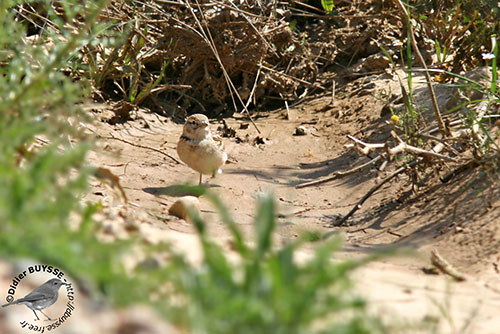
CALLS AND SONGS: SOUNDS BY XENO-CANTO
The Greater Short-toed Lark’s common call is a dry chirruping “dreet” or “drrr-t-t” often repeated. We can also hear a short “tewp” or a harder trill and a plaintive “teeoo”.
When the birds migrate in flocks, they give a more liquid note, “tshilp”, similar to that of the Tawny Pipit.
The song varies between a dry twittering and more varied, imitative melody. We can usually hear a high-pitched, musical trill and several short phrases. The song is variable and melodic with brief pauses between strophes of about 1-3 seconds.
Other longer songs with drawn-our phrases usually contain more mimicry.
BEHAVIOUR IN THE WILD:
The Greater Short-toed Lark feeds primarily on invertebrates during the spring, whereas seeds and green parts of plants are taken in other seasons. Invertebrates include mainly Coleopteran, Hemipteran and snails.
The bird forages on the ground, alone or in small or large flocks. It feeds in low, crouched posture, running in short bursts between pauses to peck food items from the ground.
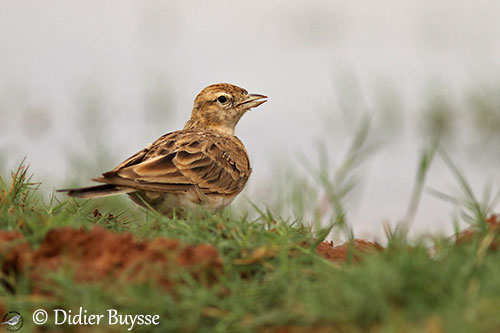
During the breeding season, the male performs aerial displays accompanied by songs.
The song flight is relatively high (30/50 metres). The bird bounces jerkily up and down while flying in small circles. The song coincides with wingbeats in abrupt undulations in circling flight. But it also sings from the ground.
This species nests on the ground in a shallow scrape built by the female. Both adults feed the chicks, but the female builds the nest and incubates alone.
They form large flocks outside breeding season.
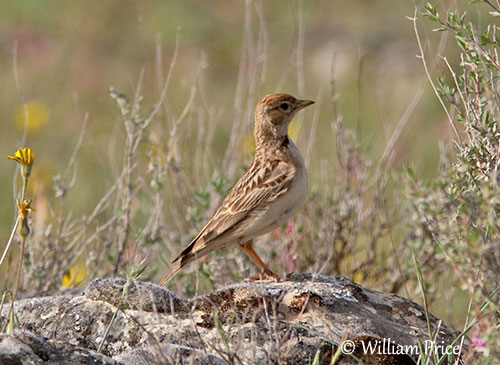
The Greater Short-toed Lark is mostly migratory, but only partially migratory in S of Palearctic range, and sedentary in Transcaucasia.
The nominate race breeds in Europe, Spain, France, Italy, the Balkans and Romania, and winters in Africa.
The flight is high and bouncing when the bird is flushed, but it become stronger when it is well underway.
The flocks keep close together while twisting and turning, and seeming to “flow” together over the ground.
During winter, they fly in large and compact flocks swinging in synchrony.
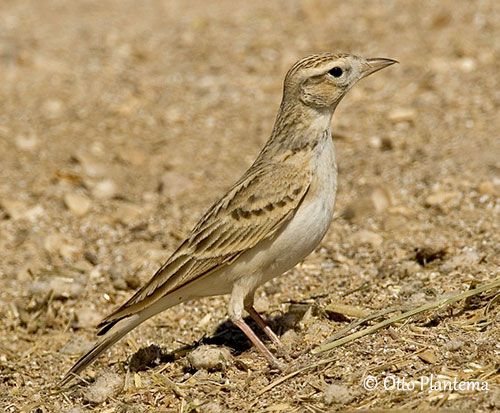
REPRODUCTION OF THIS SPECIES:
The laying takes place in May/July in SW Europe, from mid-April in SE Europe, and from early April in N Africa and Israel. This species produces two broods per season, occasionally three.
The nest is built by the female in a shallow scrape on the ground. The nest is made with grasses and rootlets, and the cup is lined with finer and softer material. There is often a small rim made with sticks or stones, and the nest is often placed near grass tuft or shrub.
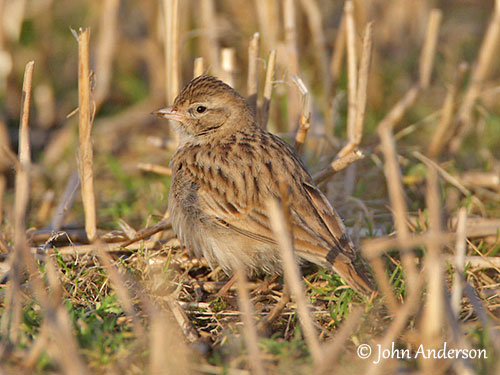
The female lays 2-5 whitish/buff eggs with fine, brownish markings. A replacement clutch is laid if the first is lost. The incubation lasts 11-13 days, by the female alone.
The chicks are fed and raised by both parents. They fledge 12-15 days after hatching. They still depend on adults for 1-3 weeks.
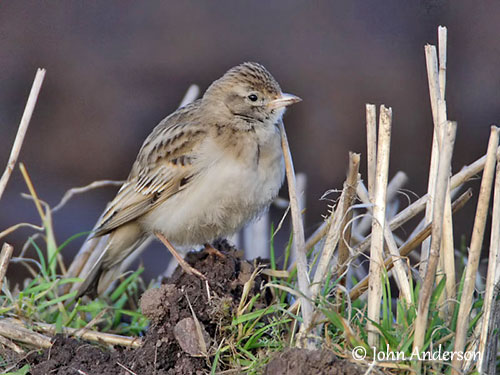
PROTECTION / THREATS / STATUS:
The Greater Short-toed Lark is described as common to locally abundant in many parts of the large range.
It is mainly threatened by agricultural expansion involving habitat loss, and afforestation of wastelands. Intensification of urbanisation, especially in Spain, is also a threat.
During the breeding season, nest losses are often very high, up to 80%. The main predators are the snakes, the Hooded Crow and the Least Weasel (Mustela nivalis). In addition, some nests are also destroyed by trampling by livestock.
The European population is estimated to number 9,460,000 / 18,100,000 mature individuals (2015). It is suspected to be stable.
The Greater Short-toed Lark is not globally threatened, and the species is currently evaluated as Least Concern.
